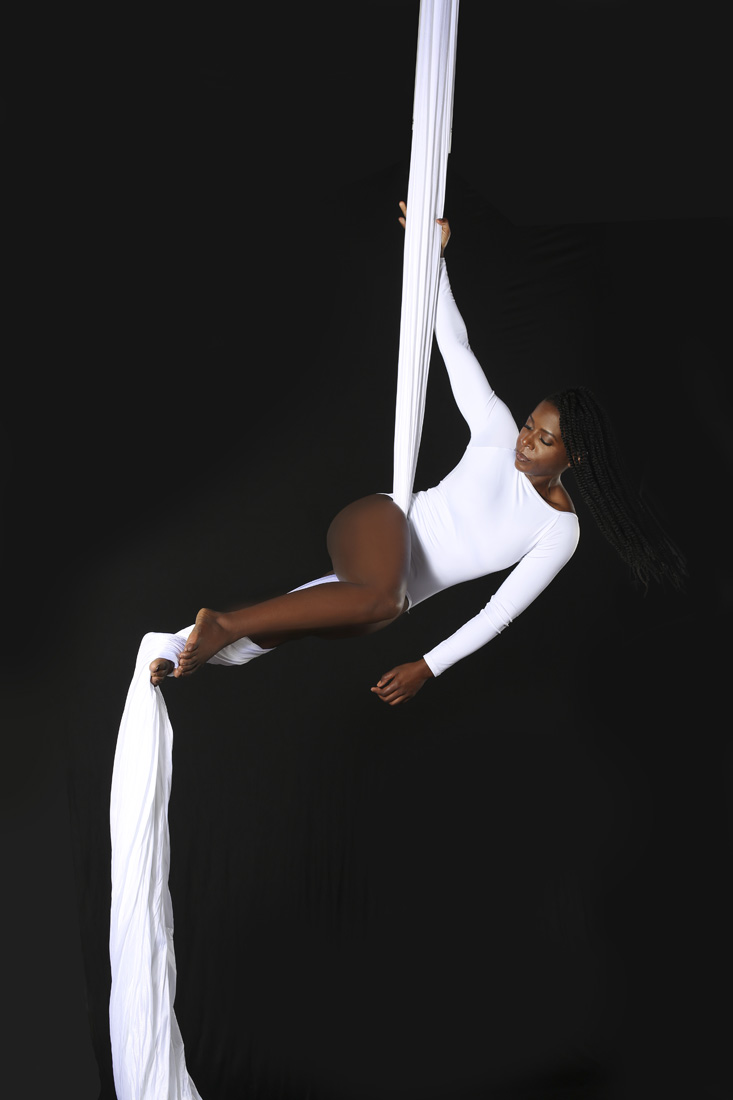Learning To Fly

Head over heels for aerial Arts.
he first time I saw aerial arts in action was at Cirque du Soleil, where a couple was performing contemporary dance movements about 15 feet in the air, holding up their body weight using only one set of aerial silks. I was fascinated by the level of strength that was required.
What seemed to be a faraway goal turned out to be closer than I thought when I did a Google search to find Inspire Aerial Arts tucked away on Amsterdam Avenue in Midtown. I signed up for the “Introduction to Aerial Dance” class, despite the fact I’m not a dancer or a gymnast. I’m a runner. Little grace involved, but a lot of endurance.
Kimberly Sende, the owner of Inspire, shares some insight with me before my class. “The greatest challenge for most people starting aerial arts is getting rid of the misconception that you have to have a lot of upper body strength and be very flexible,” she says. “While having an athletic background certainly helps, everyone has to crawl before they can walk.”
I take the advice to heart as I go to the intro class and join 11 other students. Alicia Dixon, our instructor, starts by asking, “Who has done an aerial arts class before?”
No one raises a hand. Good, we are all newbies. I find that many of Inspire’s students are just looking for an alternative way to work out that doesn’t involve the gym. Some are former dancers interested in strength building, while others have no movement background at all but wanted a fun, challenging workout.
Within the first 15 minutes, we were “learning to fly,” as Dixon said, even if only three feet off the ground. In groups of three, we took turns mimicking Dixon’s moves on the silks. The possibilities of poses are endless. Some are simple, such as holding each tail of the silk in your hand and running into a gliding pose. Others involve some guts, such as the upside down splits or the scorpion that involved flipping upside down and grabbing an opposite foot in hand.
Each of the new poses I perform make me feel a little more confident, and I could tell my classmates feel the same. As the class progresses, they begin taking photos and posing for their cameras.
By the end of the hour-long introduction class, I feet a slight soreness in my abs and arms. The poses had required arm strength to pull into position on the silks, and core strength to move into inverted poses. But I was having so much fun that I hardly noticed my muscles engaging.
Once you complete the intro class, you can sign up for Aerial Hammock, where the knot, the primary place to support your foot while on the silks, is tied farther from the ground. You are higher in the air, and lose the sense of security and more strength is required for poses. From there, students move on to intermediate classes that teach techniques most often seen in aerial performances: climbing, performing complex sequences done from 10 to 15 feet in the air, dropping back down to the floor.
“The wonderful thing about aerial arts is that it’s a form of expression that meets you where you are and gives you a great sense of accomplishment, no matter how often you practice,” Sende tells me. “If someone wanted to pursue this art form and get stronger, I recommend practicing and coming to class at least twice a week.”
As with honing any skill, if your efforts are sporadic, you’ll find yourself having to backtrack until you build up the muscle memory. I haven’t decided if I want to pursue aerial arts or do it as a change of pace from my endurance training. Regardless, next time I see a Cirque performance, I’ll remind myself that they, too, started just a few inches off the ground.
Inspire Aerial Arts
549-5 Amsterdam Ave., 30306
404.465.4139
inspireaerialarts.com
STORY: Alexa Lampasona
Photo: Sara Hanna













